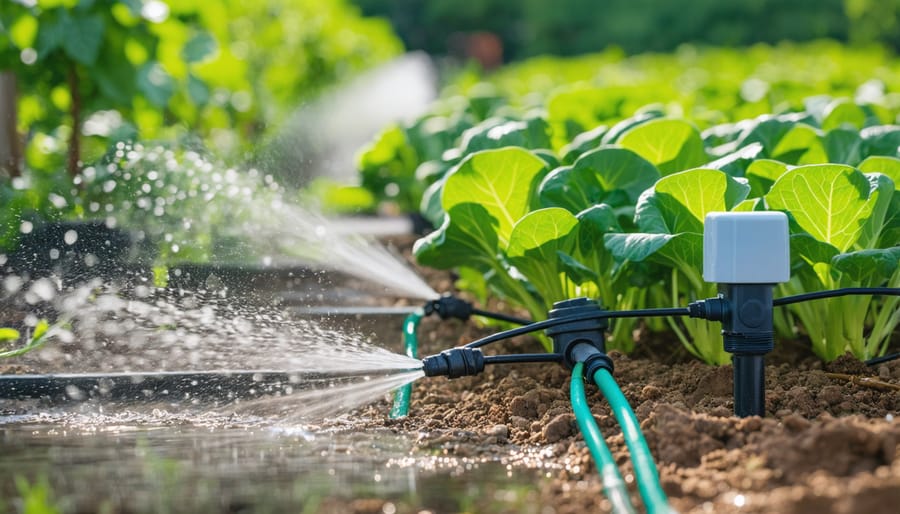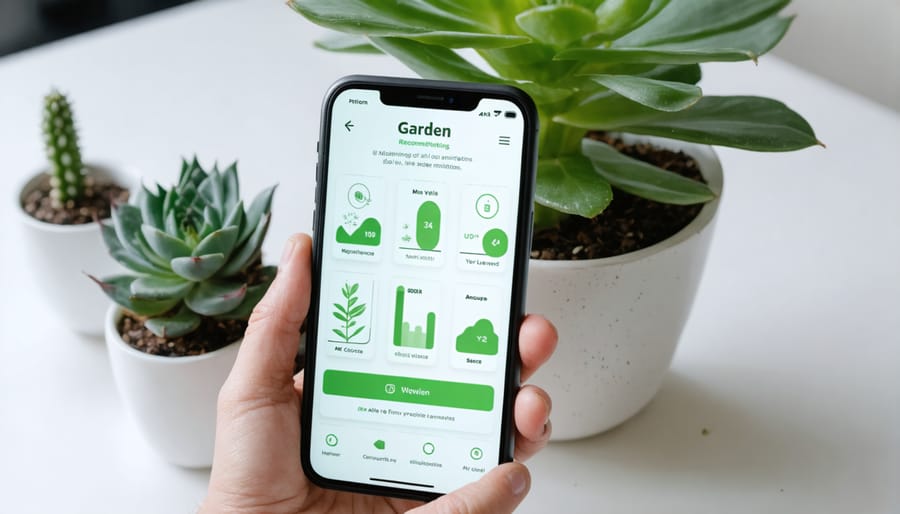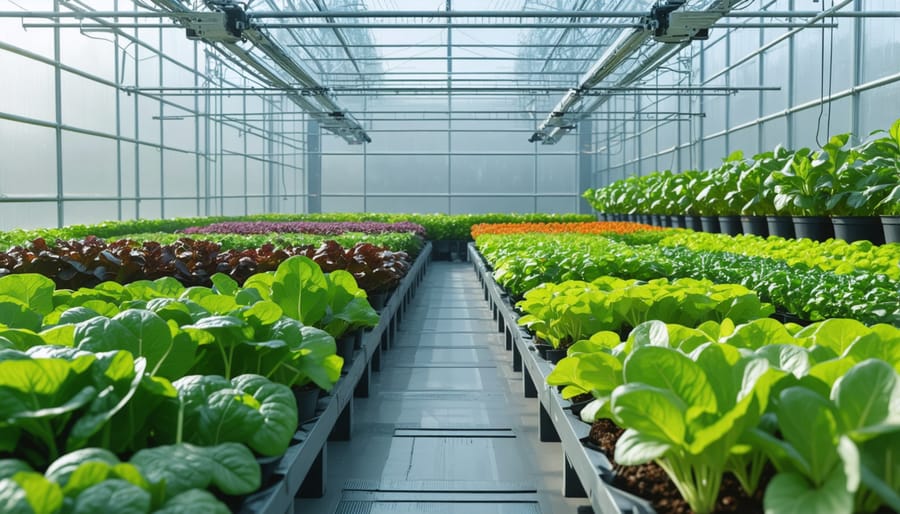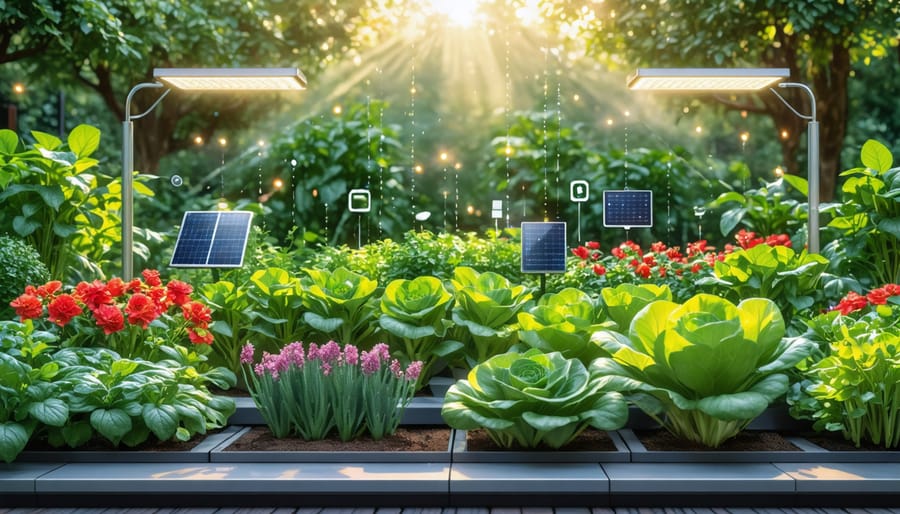Transform your garden into a smart, efficient oasis by integrating automated watering systems with moisture sensors that deliver precise amounts of water exactly when plants need it. Install solar-powered LED grow lights on adjustable timers to extend growing seasons and nurture indoor plants year-round, while reducing energy costs by up to 70%. Connect weather-responsive controllers to your irrigation system, automatically adjusting watering schedules based on local rainfall and temperature data to prevent overwatering and reduce water waste.
Smart gardening isn’t just about high-tech solutions – it’s about working smarter, not harder. Create self-watering planters using recycled containers and wicking systems that maintain consistent soil moisture for weeks. Deploy companion planting strategies by grouping water-loving plants together and using drought-resistant varieties in areas that receive less irrigation. Implement vertical gardening systems with built-in fertigation capabilities to maximize space while minimizing maintenance time.
Modern sensors and smartphone apps now enable real-time monitoring of soil pH, nutrient levels, and growth patterns, letting you adjust care routines instantly. These data-driven insights help create optimal growing conditions while reducing resource consumption and maintenance requirements, making sustainable gardening more accessible than ever.
Automated Watering Systems That Pay For Themselves
Soil Moisture Sensors: Your Garden’s Best Friend
Ever wondered if you’re giving your plants too much or too little water? Soil moisture sensors take the guesswork out of watering, acting as your garden’s personal health monitor. These smart devices are game-changers when paired with automated watering solutions, ensuring your plants get exactly what they need, when they need it.
These nifty gadgets work by measuring the water content in your soil and can be as simple as a basic probe or as sophisticated as a wireless sensor that sends readings straight to your smartphone. When the soil becomes too dry, they’ll alert you or trigger your irrigation system automatically – no more forgotten plants or accidental overwatering!
Installing moisture sensors is surprisingly straightforward. Simply place them in the root zone of your key plants or in different areas of your garden. Most sensors come with clear markings to show optimal moisture levels for different types of plants, making it easy to maintain the perfect balance.
The benefits go beyond convenience. By preventing overwatering, these sensors help protect your plants from root rot and fungal diseases while conserving water. You’ll notice healthier plants, lower water bills, and more free time to enjoy your garden rather than worry about watering schedules.

Weather-Based Controllers Worth Your Money
Taking the guesswork out of watering your garden has never been easier thanks to modern weather-based irrigation controllers. These smart devices are game-changers for both your plants and your wallet, automatically adjusting your watering schedule based on real-time weather data.
Our top pick is the Rachio 3, which connects to local weather stations and automatically skips watering when rain is forecasted. It learns from your garden’s specific needs and can save up to 50% on your water bill. For budget-conscious gardeners, the Rain Bird ST8I-WIFI controller offers excellent value, providing smart weather monitoring at a more accessible price point.
The B-hyve from Orbit deserves special mention for its user-friendly app and detailed weather tracking. It factors in temperature, rainfall, and wind speed to create the perfect watering schedule for your garden. Plus, its freeze protection feature prevents system damage during unexpected cold snaps.
When choosing a weather-based controller, look for these key features:
– WiFi connectivity for real-time weather updates
– Smart phone app integration
– Multiple zone programming
– EPA WaterSense certification
– Simple installation process
Remember, while these controllers require an initial investment, they typically pay for themselves within one to two growing seasons through reduced water usage and healthier plants.
Plant Monitoring Made Simple
Smart Sensors That Actually Work
Gone are the days of guessing whether your plants need water or nutrients. Today’s smart sensors actually deliver on their promises, making plant care more precise and less stressful. The Soil Moisture Meter Pro stands out for its accuracy and simplicity – just stick it in the soil, and its clear digital display shows exactly how thirsty your plants are. For those managing multiple plants, the Plant Link system connects to your smartphone and sends notifications when specific plants need attention.
Temperature and humidity sensors like the SmartGrow Monitor help maintain ideal growing conditions, especially for indoor gardens. What makes it particularly useful is its historical data tracking, allowing you to spot patterns and adjust care routines accordingly. For outdoor gardens, weather-resistant sensors like the RainPoint can measure rainfall and soil conditions, helping you optimize watering schedules.
The most practical combination we’ve tested is a basic moisture sensor paired with a light meter. This duo covers the two most critical aspects of plant care without breaking the bank. When choosing sensors, look for those with long battery life and simple interfaces – fancy features often go unused and just add complexity. Remember, the best sensor is one you’ll actually use consistently.

Mobile Apps That Help Your Garden Thrive
Your smartphone can become a powerful gardening companion with these innovative apps designed to make plant care easier and more efficient. From tracking watering schedules to identifying plant diseases, these digital tools put expert knowledge right at your fingertips.
PlantSnap helps you identify unknown plants and provides care instructions specific to each species. Simply take a photo, and the app tells you what you’re growing and how to nurture it. For scheduling care tasks, try Planta, which creates customized watering, fertilizing, and pruning reminders based on your specific plants and local climate conditions.
Garden Tags is perfect for social gardeners, allowing you to document your garden’s progress, connect with other plant enthusiasts, and get advice when needed. If you’re concerned about pests or diseases, PictureThis can diagnose plant problems through photos and suggest treatment options.
For vegetable gardeners, From Seed to Spoon offers detailed growing guides and tells you the best times to plant based on your location. Many of these apps offer free versions with basic features, letting you test them before committing to premium features.
Remember to combine these digital tools with your own observations and experience – they’re meant to support, not replace, your gardening intuition.
Automated Climate Control Systems

Temperature Management That Makes Sense
Maintaining the perfect temperature for your plants just got easier with smart climate control solutions. Modern greenhouse and indoor garden management has evolved beyond basic thermometers and manual ventilation. With smart thermostats designed specifically for growing spaces, you can create the ideal environment for your plants to thrive.
These intelligent systems use sensors to monitor temperature and humidity levels continuously, making automatic adjustments through connected fans, vents, and heating elements. For indoor growers, grow tent automation can maintain precise climate conditions without constant monitoring.
Setting up a smart temperature management system is surprisingly straightforward. Start with a basic smart thermostat and couple it with automated vent controls. Many systems now come with smartphone apps, allowing you to monitor and adjust conditions from anywhere. You can even set different temperature profiles for day and night cycles, mimicking natural growing conditions.
Cost-effective options include programmable vent controllers that open and close based on temperature thresholds, and smart plug-connected fans that activate automatically when needed. For added precision, consider adding humidity sensors to create a complete climate control solution that keeps your plants happy year-round.
Remember to position sensors at plant level for the most accurate readings, and always include backup manual controls in case of system issues. With these smart solutions, you can say goodbye to constant temperature monitoring and focus on enjoying your garden.
Light Control for Year-Round Growing
One of the biggest game-changers in modern gardening is automated lighting control, which lets you grow thriving plants year-round, regardless of natural light conditions. LED grow lights have revolutionized indoor gardening, offering customizable light spectrums that match plants’ specific needs while consuming minimal energy.
Setting up smart lighting is easier than you might think. Start with programmable LED strips or smart bulbs that connect to your home’s WiFi network. These can be controlled through your smartphone, allowing you to adjust intensity and duration based on your plants’ requirements. For beginners, a simple timer-based system with full-spectrum LEDs works well for most houseplants and herbs.
The key is creating a consistent light schedule that mimics natural sunlight patterns. Most plants thrive with 12-16 hours of light daily, though this varies by species. Smart sensors can automatically adjust light levels based on natural sunlight, ensuring your plants receive optimal exposure without wasting energy.
Pro tip: Position your lights 6-12 inches above your plants and adjust the height as they grow. For maximum efficiency, consider using reflective materials on nearby walls to bounce light back onto your plants. Remember to regularly clean your light fixtures, as dust can reduce their effectiveness by up to 15%.
Smart Garden Security Solutions
Motion-Activated Pest Control
Keep unwanted visitors away from your precious plants with modern motion-activated pest control systems. These smart devices combine sensors, sprinklers, and sometimes even lights to create an effective barrier against garden intruders like deer, rabbits, raccoons, and other wildlife.
The most popular options use infrared sensors to detect movement, triggering a quick burst of water that startles animals without harming them. Some advanced models even connect to your smartphone, allowing you to monitor activity and adjust sensitivity settings remotely. You’ll receive notifications when the system activates, helping you track patterns in animal visits.
For maximum effectiveness, consider installing multiple units to create overlapping zones of protection. Position sensors at common entry points and around your most valuable plants. Many gardeners combine water sprayers with motion-activated lights for nighttime protection, as the sudden combination of water and illumination proves particularly effective at deterring nocturnal creatures.
These systems are surprisingly energy-efficient, operating on batteries or solar power, and most use minimal water. The key is proper placement – mount sensors at animal height (usually 2-4 feet off the ground) and angle them slightly downward to avoid false triggers from wind-blown plants.
Pro tip: Start with the most sensitive settings and gradually adjust them down to prevent unnecessary activation from smaller, harmless creatures like birds or squirrels. This helps conserve water and extends battery life while maintaining protection against larger pests.
Weather Protection Systems
Protecting your garden from extreme weather doesn’t have to mean constant monitoring and last-minute scrambling. Modern weather protection systems can automatically shield your plants when Mother Nature decides to act up. These smart solutions combine sensors, motors, and durable materials to create a protective shield exactly when needed.
Automated retractable covers are the workhorses of weather protection. These systems use weather sensors to detect rain, strong winds, or extreme temperatures, automatically extending protective covers over your garden beds. Some advanced models even integrate with weather forecast data to prepare for incoming storms before they arrive.
For greenhouse environments, smart ventilation systems work alongside automated shade cloths to maintain optimal growing conditions. When temperatures spike, these systems can open vents and extend shade covers to prevent heat damage. During cold snaps, they close up tight to retain warmth.
Consider installing modular hail nets that can be programmed to deploy based on weather alerts. These specially designed nets can save delicate plants from devastating hail damage while allowing sufficient light and rain to pass through when conditions are favorable.
For container gardens and raised beds, automated mini-greenhouses offer targeted protection. These compact units feature motorized panels that adjust throughout the day, providing the perfect balance of protection and exposure. Many can be controlled through smartphone apps, letting you fine-tune your garden’s protection even when you’re away.
The initial investment in these systems pays off by preventing crop losses and reducing the time spent rushing to protect plants during sudden weather changes.
Embracing smart gardening techniques isn’t just about keeping up with technology – it’s about creating a more sustainable, efficient, and enjoyable gardening experience. By implementing these innovative solutions, you can reduce water consumption, save time on maintenance, and create a thriving garden that practically takes care of itself.
Whether you start small with a simple automated watering system or go all-in with a fully connected smart garden, every step toward smarter gardening is a step toward a more sustainable future. The beauty of these solutions lies in their flexibility – you can adapt them to suit your space, budget, and lifestyle while still reaping significant benefits.
Remember that smart gardening isn’t about replacing the joy of getting your hands dirty – it’s about enhancing your gardening experience by eliminating tedious tasks and providing valuable insights about your plants’ health and needs. The time you save on routine maintenance can be spent on more rewarding aspects of gardening, like planning new layouts or experimenting with different plant varieties.
As we move toward a more connected world, smart gardening solutions will continue to evolve and improve. By starting your smart gardening journey today, you’re not just making your life easier – you’re contributing to a more sustainable and efficient approach to growing plants. Take that first step, start with one or two smart solutions, and watch your garden transform into a more productive and enjoyable space.





